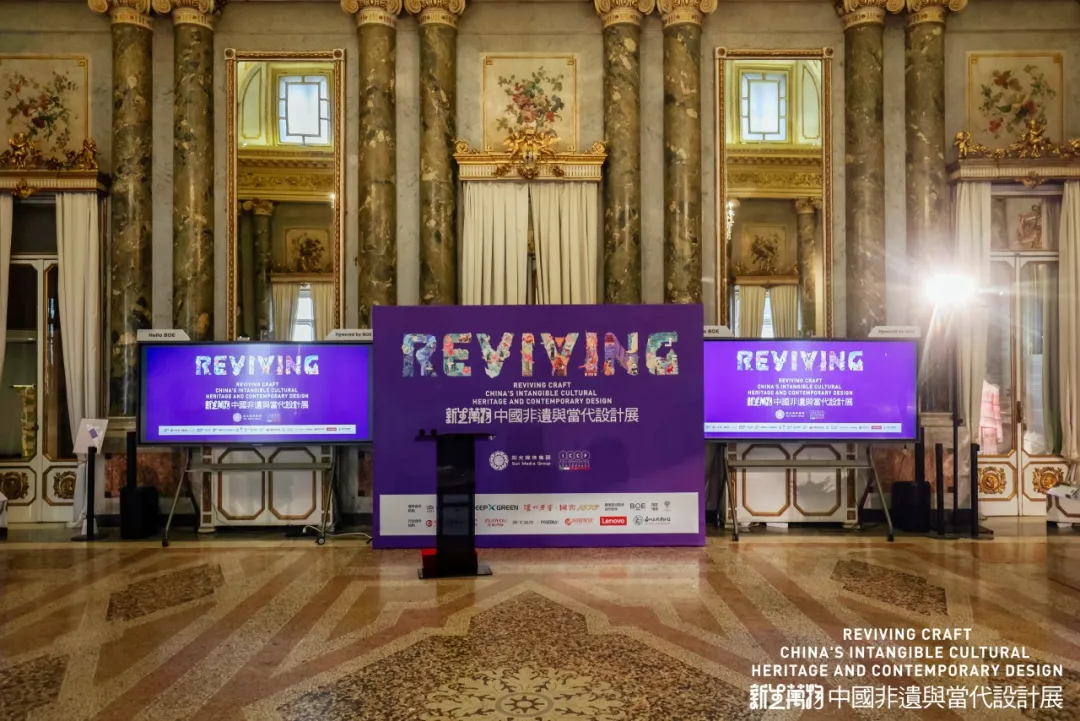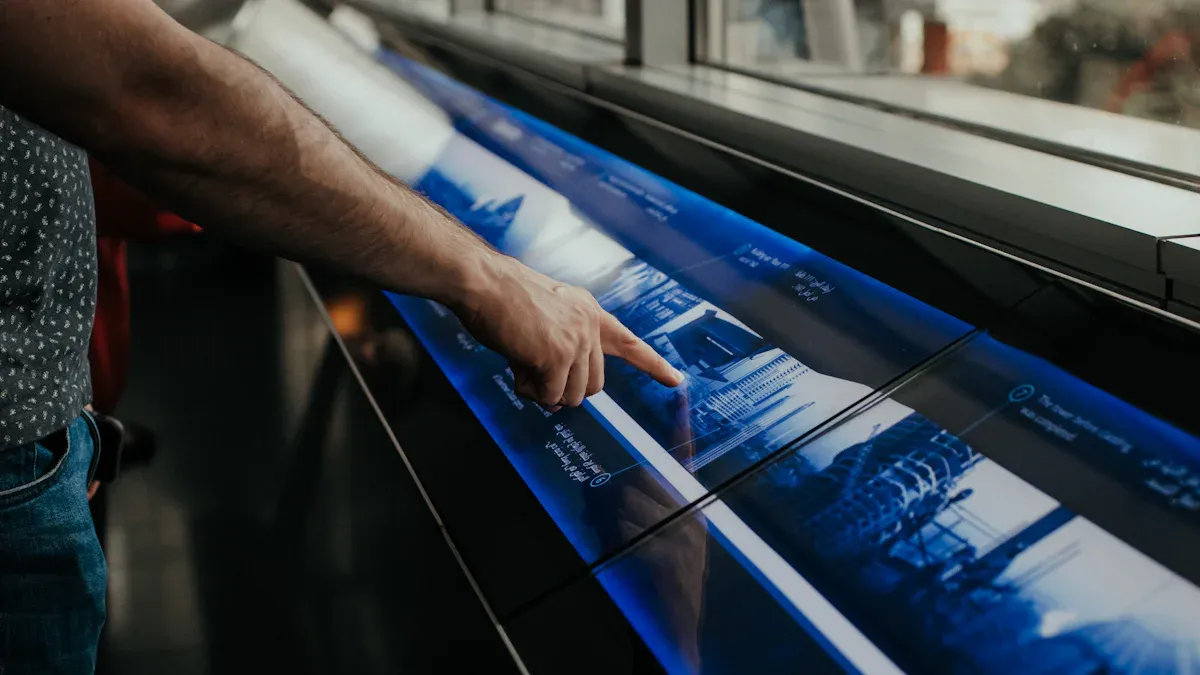Must-Watch Innovations in Museum Digital Screens for 2025

You can now visit museums in new ways because of better museum digital screen technology. All over the world, digital screens help people get more interested. In the Americas, you see big video walls and interactive screens. These let you look at exhibits in fun ways. Museums in Europe and Asia use eco-friendly and AI-powered digital experiences. Interactive digital displays, like those shown by 京东方BOE at the reviving craft china‘s intangible cultural heritag event, help you feel and think about art and history.
Key Takeaways
Digital screens make museum trips more fun. They let people interact with exhibits. Visitors can touch things and learn in cool ways.
AI personalization changes museum visits for each person. It gives custom tours and stories. This makes every trip special.
AR and VR change how people see culture and history. These tools build exciting places that grab attention.
Energy-efficient displays help museums save money. They also lower harm to the environment. Using green ideas is now very important.
QR codes make things easier and more fun. They give quick facts and help visitors enjoy their time more.
Museum Digital Screen Trends
Museum digital screens are changing quickly. Every year, new trends appear. In 2025, the changes are very exciting. These trends change how you see exhibits. Museums use digital screens to connect with visitors. Let’s look at the newest trends and how they affect exhibits.
Trend | Description |
|---|---|
VR and AR let you explore and interact with artifacts. This makes visits more fun. | |
AI and Personalization | AI tools give you custom tours and audio guides. They change your visit based on what you like. |
Digital Engagement and Accessibility | Mobile apps help you with maps, videos, and tours. You can guide yourself through the museum. |
Community Engagement | Museums offer classes, workshops, and let people join in exhibits. |
Digital Preservation and Digitization | Digital twins help save artifacts and share collections online. |
Cloud-Based Ticketing | You get tickets on your phone and enter without paper. This helps the planet and makes visits easier. |
Exhibit design now uses more digital screens and new technology. 京东方BOE is a leader in this field. At the Milan show, BOE showed off clear screens, UHD screens, and smart calligraphy tables. These new tools help museums make ar experiences and show history in cool ways.
AI Personalization
AI personalization is a big trend in exhibit design. When you go to a museum, AI asks what you like. It makes a special tour just for you. If you love art, it shows you paintings and sculptures. If you like history, it shows you old objects and stories.
Implementation Method | Description |
|---|---|
Pre-Visit Customization | A digital helper asks about your likes before you arrive. |
AI makes a tour that matches your interests. | |
Adaptive Storytelling | The museum changes stories for your age and skill. |
Intelligent Chatbots | AI chatbots answer questions and talk with you about exhibits. |
Quantitative Measurement | The system checks what you do and asks for feedback after your visit. |
Qualitative Measurement | Staff watch visitors and ask groups about their feelings and thoughts. |
You can try this at BOE’s smart calligraphy table. The table uses AI to help you with your writing. It changes to match your skill and teaches you calligraphy in a fun way. This makes every visit special and just for you.
AR and VR Experiences
AR and VR are changing how you see exhibits. These tools let you visit virtual places and see objects in new ways. AR puts digital pictures on real things. VR takes you to other times and places.
Example | Description |
|---|---|
AR-based exhibits | AR turns old displays into fun, interactive stories. |
VR-established heritage tours | VR lets you travel to the past and learn about culture. |
AR interactive learning exhibits | AR helps students and families learn hard topics in a fun way. |
VR cultural exploration | VR shows you new cultures, even if you can't travel. |
AR gamified experiences | AR mixes games with learning to make history fun. |
VR helps museums share culture with more people.
Virtual tours let anyone see museum collections online.
You can see collections on many devices.
At the Milan show, BOE’s clear screens show details of Chinese wooden bridges. UHD screens play animated stories, like the tea and wine debate. These ar experiences help you learn about culture and history in new ways. Exhibit design now uses ar and vr to make learning fun.
Energy-Efficient Displays
Saving energy is important in new digital screens. Museums want to use less power and help the environment. Energy-saving screens last longer and cost less. This helps museums save money and lower pollution.
Technology Type | Description |
|---|---|
Transparent Displays | These screens show how Chinese bridges are built and make the experience more real. |
UHD Screens | UHD screens show animations like concerts and children playing, making stories better. |
This desk lets you try calligraphy and learn about "harmony without uniformity." |
BOE’s screens use green materials and smart power controls. At the Milan show, you see how digital screens help save culture and protect nature. Exhibit design now uses energy-saving screens and digital tools for a better future.
You can see these trends at real museum shows. The Milan event uses clear screens, UHD screens, and smart calligraphy tables together. These new tools make exhibits more fun, green, and interesting for everyone.
Interactive Digital Displays

Interactive digital displays are making exhibitions more fun. You do not just look at things behind glass anymore. Now you can touch, move, and explore exhibits in new ways. These displays make learning easier and more exciting. Many people think regular exhibits are boring. Interactive digital displays use moving images and sounds to make history interesting. You get to join in, not just watch. This makes you feel like you are part of the exhibit.
BOE’s smart calligraphy table is a good example. You can practice calligraphy on a screen. The table follows your hand and helps you get better. Interactive walls let you explore by moving your hands or waving. These tools make learning simple and fun. Most people say they enjoy using digital displays and want to see them in other places.
Touchless Controls
Touchless controls are getting more popular in exhibits. You can wave your hand or move your body to use digital displays. This keeps screens clean and makes things safer. Museums use sensors and gesture recognition so you do not have to touch anything.
You might see a display where you shape clay in 3D by moving your hands.
Some exhibits use holograms. You can interact with virtual statues by waving.
Gesture devices let you look at artifacts in a digital museum.
Hybrid systems help you see and move objects easily.
Sometimes, people get confused if the display does not respond. Museums add sounds and lights to show when your actions work. These changes make exhibits easier and more fun to use.
Multi-User Collaboration
Exhibits now let groups learn together. Interactive digital displays let you and friends work as a team. You can solve puzzles, make art, or learn about history together. Working with others makes exhibits more special.
Aspect | Description |
|---|---|
Engagement | |
Learning Styles | They use videos, pictures, and sounds for different learners. |
Group Learning | You can learn with friends and share ideas outside the exhibit. |
Real-time Feedback | Displays give quick feedback to help you learn. |
Data Collection | Museums collect info to make exhibits better for everyone. |
Many displays are made for more than one person. You can talk, work together, and share ideas. This helps you see new opinions and learn more. Systems like Holo-Artisan use 3D and AI to make shared spaces. You get answers just for you while working with others, making teamwork stronger.
QR Code Integration
QR codes are used a lot in exhibits. You scan a code with your phone to get more information. This saves space and keeps the exhibit neat. QR codes make exhibits more fun and easy to use.
Year | Alphanumeric Code Usage (%) | |
|---|---|---|
2020 | 35.4 | N/A |
2022 | 97.9 | N/A |
QR codes help you see videos, read stories, or listen to guides in many languages. Museums use QR codes to get feedback and make future exhibits better. You get a better visit and museums learn what you like.
QR codes make exhibits more interactive.
You can get info in your own language.
Museums use data to improve exhibits.
Interactive digital displays are changing how exhibits are made. You get more ways to join in, learn, and have fun. Exhibits now use smart tables, interactive walls, and QR codes to make learning better.
Digital Experiences in Museums
Digital experiences are changing museum visits. You get more choices and feel part of the exhibit. Museums use digital screens to show art and history in new ways. AR and VR make visits more fun and interesting. You see both real and digital displays together. This makes your trip exciting.
Personalized Content
You get special content when you enter an exhibit. Geofencing sends messages when you walk by displays. Push notifications tell you about new things to see. Artificial intelligence helps match exhibits to what you like. You see facts and stories that fit your interests. Smart systems keep information fresh for you. AI changes stories so they match you better. You feel closer to the exhibit and enjoy it more.
Geofencing sets up invisible lines around displays.
Push notifications give you news about exhibits.
AI picks content you like for a better visit.
Self-Guided Tours
Self-guided tours let you go at your own speed. You use digital screens to learn about displays. AR helps you understand museum buildings and objects. Museums now focus on making visits fun, not just showing things. You enjoy your visit more and learn new things.
Evidence | Description |
|---|---|
Interactivity | Interactive displays make visits more fun and satisfying. |
Perceived Enjoyment | You feel happier and more interested in exhibits. |
Learning Enhancement | AR helps you learn about collections and design. |
You pick what you want to see and do. This makes every visit different for you.
Immersive Storytelling
Immersive storytelling uses UHD screens and moving pictures. You watch stories in clear, bright colors. At BOE’s Milan show, you see debates about tea and wine on a big UHD screen. Clear screens show how Chinese bridges are built. Smart calligraphy tables help you practice writing and learn about Eastern ideas. Museums mix old art with new tech for better exhibits.
Museum Name | Description |
|---|---|
Moesgaard Museum | |
National Museum of Qatar | You watch films in 8K that show Qatar’s history. |
You use touch, sound, and sight in these exhibits. Interactive theater and special lights make stories stand out. Museums now use these tools to help you learn about history and culture.
Digital tools make exhibits more creative. You learn and enjoy more when museums use both technology and tradition.
Accessibility and Sustainability
Inclusive Design
Museums want everyone to feel welcome. Inclusive design helps all visitors enjoy exhibits. Museum digital screens have features for this. You can make text bigger to read easier. Audio descriptions help people who cannot see well. Captions and screen readers help those with hearing or vision problems. You can pick your language with multilingual options. Interactive displays work for different learning styles. You can use them in your own way. Clear signs and digital kiosks help you find your way.
You can change text size and listen to audio.
Captions and screen readers help more people.
You can pick your language.
Interactive displays work for everyone.
Digital signs help you move around.
These features help everyone join in and have fun.
Eco-Friendly Solutions
Museums care about the planet. Using digital tickets and guides saves paper. Digital membership cards mean less plastic waste. New LED and OLED screens use less energy. This lowers bills and helps the earth. Museums pick energy-saving screens for their green goals. Digital tools also save money on paper and mail. Green digital signs help by making less waste and using less power.
LED and OLED screens use less energy.
Digital cards mean less plastic.
Green signs make less waste.
BOE is a leader in green museum design. At the "Reviving Craft" show, BOE showed smart calligraphy desks. These desks help save culture and the planet.
Lifecycle Management
Museums think about how long displays last. Teams check materials for how long they last and their carbon footprint. Reusing parts helps cut down on waste. Designers use ways that help nature. Passive climate control, like desiccants, saves energy. Local systems for humidity and temperature protect artifacts and use less power. Picking green parts and having a good plan keeps screens working longer.
Reuse parts from old exhibits.
Use designs that help nature.
Use passive climate control.
Take care of displays so they last longer.
BOE works hard to help the planet. They believe in living with nature and making the world better. BOE brings smart classrooms and culture classes to many places. These actions make museum design better for everyone.
Technology Trends Shaping the Future

Global Collaboration
Museums in different countries work together more now. These teams share ideas and make new digital displays. The China-Italy show in Milan is one example. Two cultures worked together to make something special. When museums team up, you see art and history from many places. This teamwork brings better technology and cooler museum screens. You learn about stories from around the world. Technology helps people connect everywhere.
Cultural Integration
Museums use digital displays to mix cultures and make learning fun. You can touch screens or wave your hands to explore. Augmented reality helps you see artifacts in new ways. These tools make hard topics easy to understand. The ArtScience Museum in Singapore mixes art, science, and tech in Future World. You see interactive exhibits with AR and mixed reality. At the Smithsonian National Museum of Natural History, you use digital maps to explore cultures. These displays make each visit special and help you remember what you learn.
Interactive displays let you use your senses to explore.
Augmented reality brings history to life.
Digital maps show you stories from around the world.
Future Innovations
Museum digital screens will change even more after 2025. Museums want displays to be more fun and personal. You might get a tour made just for you. New tech will let you use all your senses, not just sight and sound. Museums care about the earth, so they use eco-friendly materials. Social media will help you share your museum trips with friends.
Trend | Description |
|---|---|
You can join in and shape your own experience. | |
Personalization | Museums use data to give you custom tours. |
Immersive Experiences | VR and AR make exhibits feel real and exciting. |
Sustainability | Eco-friendly materials help protect the earth. |
Multi-Sensory Engagement | You use touch, sound, and even smell in new displays. |
Social Media Influence | You share your favorite moments online. |
You help shape museums by joining in and sharing ideas. Digital displays will keep changing to make visits better and more fun.
You notice museum digital screens change how you visit. Interactive displays let you join in and learn by doing. Immersive stories make exhibits more exciting for everyone. Energy-saving screens help museums welcome all visitors. Studies show digital displays help you learn with your hands. They also help you talk and work with others. Top brands like Museum Anywhere, Ideum, and Electrosonic make new kinds of screens. These screens can be changed and use cool technology. Keep looking for new ideas and enjoy what museums will offer next.
FAQ
What makes digital screens important in museums today?
Digital screens help you learn in cool ways. You can watch moving pictures and touch screens. You see stories about art and history. These tools make learning more fun. You get to explore at your own speed.
How do interactive displays improve your museum visit?
Interactive displays let you touch and move things. You can try calligraphy or solve puzzles. You can watch videos too. These activities help you remember more. You feel part of every exhibit.
Why do museums use energy-efficient screens?
Museums want to save energy and help the planet. Energy-efficient screens use less power. This lowers costs and cuts pollution. You help the earth by visiting green museums.
Can you use your phone with museum digital screens?
Yes! Many museums use QR codes now. You scan them with your phone for info. You can watch videos or listen to guides. This makes your visit easier and more fun.
What is special about 京东方BOE’s display technology?
京东方BOE makes clear, bright screens and smart tables. You see small details in art and history. Their technology lets you interact with exhibits. You learn about culture in new ways.
See Also
Unveiling BOE’s Versatile Display Technologies Shaping Consumer Electronics
Ten Remarkable Outdoor Digital Signage Projects Globally
Best Digital Signage Screens for Professional Use
Latest Developments in Smart Board Solutions for Enterprises
Evaluating Leading Digital Signage Software Options for Companies